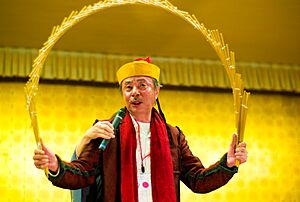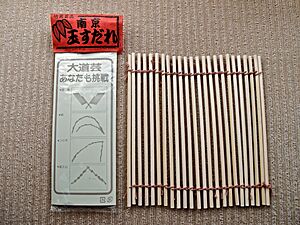Nankin Tamasudare facts for kids
Nankin tamasudare (南京玉簾 or 南京玉すだれ, Nankin-tamasudare, lit. "Nanjing Lily") is a super cool traditional Japanese street performance! Imagine someone skillfully moving a special screen made of loose sticks, while also singing a fun, rhythmic poem. It's like magic how they make the screen change into different shapes right before your eyes!
The name Nankin tamasudare is a bit of a clever wordplay. It can sound like a type of flower, but it also means something like "a wonderful woven screen." A sudare is a traditional Japanese screen made by weaving straw or bamboo.
During the performance, the artist chants a rhythmic poem. As they chant, they use the special screen to show the objects mentioned in the poem. They twist, fold, and extend the screen in many ways to create different shapes. Then, they quickly bring it back to its original flat screen shape. The chant often ends with a pun or a play on words. For example, kaeru nai can mean there is no frog under a willow tree, but it also means the willow tree shape cannot easily return to its original screen form. The performance usually finishes with the willow tree shape, and the artist slowly packs up their mat.
Nankin tamasudare became popular during the Edo period in Japan. Today, you can sometimes see this amazing performance at Japanese cultural festivals. It's a fun way to experience a piece of Japan's history and art!
The Performance Chant
The chant is a very important part of the Nankin tamasudare performance. It guides the audience through the different shapes the screen creates. There are many versions of the chant, but they all follow a similar pattern. The performer sings a poem, and with each part, they quickly change the screen into a new shape.
For example, the chant might start by saying:
- "Hurry, hurry, it's the Nanjing Woven Screen!"
- "Extend it just a little, and it looks a bit like Urashima Tarō's fishing rod!"
As the performer sings these lines, they would quickly transform the screen into the shape of a fishing rod. Then, they would bring it back to its original screen shape before moving to the next part of the chant.
Other shapes the screen might become include:
- The Chinese bridge of Seta
- A gate to a house, which then changes into a charcoal-making shed
- A sign for a buckwheat noodle shop
- A flying carp for Boy's Day, which then becomes Tokyo Tower!
- Even a shimmering halo around a Buddha statue, like Amitābha or Śākyamuni
- A white floating sail near Amanohashidate, one of Japan's Three Greatest Sights
- The flags of the US and Japan, which then transform into a weeping willow
The chant always brings the screen back to its original shape after each object is shown. It's a fast-paced and exciting show that keeps everyone guessing what the screen will become next!



